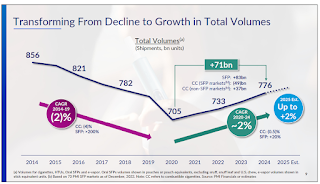PRESS RELEASE
(Ottawa
– May 26, 2025) – Deeply concerned with the impact of the previous government’s
permissive approach to nicotine vaping products, tobacco control organizations
are calling on the new government to quickly align controls on this market with
those used for tobacco.
As part of these important reforms, they are asking for
regulations to ban flavours in vaping products to be finalized within the
Health Minister’s first 100 days in office. Restricting flavours in vaping
products was a commitment made by the Liberal Party in the recent federal
election.
“Minister Michel has inherited the youth vaping crisis, and
her intervention is urgently needed to clean up the mess her predecessors left
behind,” said Les Hagen, Executive Director of Action on Smoking &
Health. “This will require her to stand up to the tobacco industry and its
front groups, and to protect youth from their attempts to undermine health
policies.”
“The youth vaping crisis has gone on far too long,” he added.
“The past government’s decision to liberalize the sale of vaping products has
negatively impacted one-half of Canadian youth without producing any measurable
benefit in overall smoking cessation among adults.”
Vaping products became legal for sale and promotion in
Canada in May 2018,
and were exempted from the marketing restrictions that have been proven to help
protect young people from starting to use tobacco products. These measures include
large graphic health warnings, plain and standardized products and packaging,
bans on flavourings and sweeteners, and controls on accessibility including a ban
on interprovincial sales.
“Over the past seven years, parents, teachers and health
professionals have struggled to protect kids from the predatory commercial
activities which followed,” said Flory Doucas, co-director of the Quebec
Coalition for Tobacco Control. “They have waited for meaningful federal government
action while hundreds of thousands of children were being recruited to nicotine
addiction by an industry sugar-coating a harmful drug with exotic flavours and
playful devices.”
Health Canada’s 2023 Canadian Substance Use Survey found that over one million Canadian
teenagers aged 15-19 (48%) had tried vaping products, 681,000 (31%) had used
them in the past month and that 400,600 (17%) were vaping on a daily basis.
“We cannot afford for this government to sit on its hands or
take the same laissez-faire approach to the tobacco and nicotine industry as
its predecessor,” said Cynthia Callard, Executive Director of Physicians for
a Smoke-Free Canada. “The need for stronger regulations has been recognized
by government for years, as the cost of its inaction continues to climb.”
Health Canada proposed several measures to address
the youth vaping crisis in the spring of 2019. Only one of these measures has been approved
(limiting nicotine concentration), despite ongoing appeals by health
organizations and federal and provincial Medical
Officers of Health.
Four years after draft regulations to restrict
flavourings were published, they have still not been finalized despite Ministerial promises to do so.
“The legalization of vaping products has not produced a net public
health benefit in Canada,” said Ms. Callard. “Since 2018 there has been
no increase in quit attempts or in
successful quitting among smokers, and the number of former smokers has
actually dropped.
Smoking rates are going down at a slower rate than in years prior to
the legalization of nicotine vaping products.”
Opening the vaping market allowed corporate interests to halt
the reduction in nicotine addiction. The widespread use of nicotine products
among young people means there are as many or more nicotine
users in Canada as there were before these products were legalized. Only a minority of Canadian vapers (28%) are former
smokers.
“The previous government’s preference for a poorly regulated
vaping market has facilitated the tobacco industry pivoting to other harmful
products and launching a new epidemic of nicotine addiction,” said Mr. Hagen.
Health Canada’s Canadian Substance Use Survey found that one in every three young
Canadians who had tried vaping even once were using these products on a daily
basis. Independent studies of nicotine use among youth report that young vapers
find themselves more addicted than do
young cigarette smokers. Many studies report that youth who use vaping products are much more likely to start using tobacco
products.
In addition to being highly addictive, vaping products present significant risks for cardiovascular disease, lung injury and exposure to toxins, especially given some of the
additives used to flavour liquids.
“We are not calling for a ban on vaping products,” said Flory
Doucas. “We are calling for the use of proven regulatory controls to prevent
industry from enticing young people to experiment with and become addicted to
nicotine.”
“At the current rate of initiation, the nicotine industry is
set to recruit more than 15,000 school-aged children to vaping during Minister
Michel’s first 100 days in office. She is the Canadian with the greatest power
and responsibility to bring that number down before the start of the school
year this September.”
Backgrounder can be downloaded Here.































